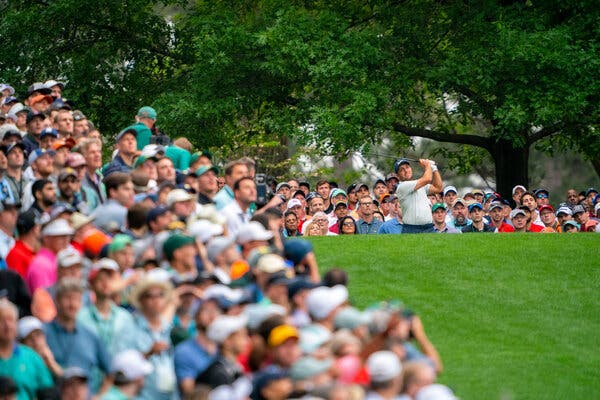The Masters does set-your-watch-to-it formality better than any sporting event. From the prominent green jacket ceremony to the mundane paint on sewer covers, every detail of the tournament is coordinated and beholden to a familiar presentation. This is how the youngest of the men’s golf major championships achieved such rapid brand strength and popularity.
Augusta National is a powerful club full of powerful people but the coronavirus pandemic had little regard for its traditions and certainly not its tournament schedule. The watches and calendars were all reset in March as golf, and the rest of the sports world, went on hold. A plan for a rescheduled Masters in November was put in place, but like so much in 2020, it will be far different from the Masters we’ve come to expect each April.
No patrons, no roars
The most conspicuous difference in the 2020 Masters will be the quiet, spectator-less grounds throughout the week. It’s been a norm in golf and other sports for months but the Masters has a special relationship to its live audience, whose members are called “patrons,” per club tradition.
An Augusta National course without patrons will look odd, but less gallery traffic is expected to open up different camera angles that TV viewers do not normally see. Quantifying a crowd’s impact on a golf tournament is a challenge, particularly on the back nine holes where Augusta’s famed roars have provided the soundtrack to the Masters most memorable finishes.
“The crowds are so big there, you try to just get involved in playing your game and not paying that much attention to the crowds,” said Tommy Aaron, who won in 1973. “But they’re there, and if you’re going well, they can give you a boost.”
“And if you’re going badly,” he added, “it can seem to be magnified.”
Earlier this summer, Tiger Woods said players were “making more birdies” during spectator-less PGA tournaments on account of “not having to deal with the amount of distractions” created by the crowds. That could provide a stark advantage, and lower scores, over the 2019 Masters, where crowds swarmed around the final group of Woods, Francesco Molinari and Tony Finau. Molinari’s tenuous grip on the lead evaporated as the round progressed, and there were even some cheers down in Amen Corner when his tee shot on 12 went into Rae’s Creek.
Cheering poor shots is verboten at the Masters and described as “most distressing” in a printed note from Bobby Jones, one of the founders, at the front of the Masters Spectator Guide. This year, Augusta National won’t have to enforce it.
Fewer azaleas, more fall foliage
The timing of the tournament in November lends itself to different playing conditions and, for connoisseurs of Augusta National’s flora, a different landscape marked more by dogwoods and maples.
The ropes and grandstands are absent this year, replaced by dark painted lines to keep the handful of people at the course out of play. And some hints of autumn color surface around the course.
Take the 12th hole, the heart of Amen Corner and in the view of many the most celebrated hole at Augusta. A right-hander at the tee box this week can glimpse reds and yellows not ordinarily seen during the Masters. The bridges over Rae’s Creek are lightly framed with fall’s hues.
Yet Phil Mickelson, a three-time Masters champion, said he had hardly noticed the colors as he played the course.
“I really don’t see much outside of the holes,” Mickelson said.
TV viewers, presumably not facing the distraction that will face Mickelson, can set aside azalea-gazing this year and keep closer tabs on the trees and how they shape the architecture of the course. Some shots, players suggested, may be more tempting because they are more visible because of the lack of leaves or, in some spots, spectators.
“It’s weird because you can see almost every hole when you’re standing on the No. 1 tee, you can look out and see everything,” Brooks Koepka said Tuesday. “I’m not used to that.”
The weather (sort of)
For all the concerns about a frigid Masters, temperatures should approximate April with forecasts of highs in the upper 70s and lows in the 60s throughout the weekend. Warming up for a round in benign early morning temperatures should come as a relief to the fused back of the 44-year-old defending champion.
Instead, thunderstorms will likely be a far greater threat than the temperature. Players said the course appeared to be playing longer and that chipping around the greens could be impacted if rain rolls across Augusta. But turfgrass experts said the greens, notoriously speedy, tricky and maintained to the point of obsession, should play similarly to April.
“That place is as different as any other course in the world,” said Gerald Henry, a turfgrass management professor at the University of Georgia. “The pressures that I’d explain that are happening at your local golf course just don’t exist out there — and that’s intentional, obviously.”
A split tee start
The small Masters field of between 90 and 100 golfers generally affords the tournament significant flexibility when it comes to scheduling tee times: They do not need to start players right at sunrise and they can send the entire field off the No. 1 tee.
With limited daylight in November, the Masters will use a two-tee start for the first two rounds. Players will begin on No. 1 and No. 10 tees in early and late morning waves on both Thursday and Friday. The tournament used the rare two-tee start for the final round last year, when it raced to beat afternoon thunderstorms that had been forecast.
Football looms
The Masters typically occupies a weekend in April that’s free and clear from the N.C.A.A. basketball tournaments and after Major League Baseball’s opening day. In November, the tournament was scheduled around and with football in mind. Executives from Augusta National, its television partner, CBS, the N.F.L., and the Southeastern Conference all worked together on this weekend’s scheduling.
Saturday’s television coverage schedule runs from 1 to 5 p.m. Eastern and Sunday’s coverage runs from 10 a.m. to 3 p.m. Eastern, with CBS subsequently broadcasting three late afternoon N.F.L. games. The planned Sunday conclusion will be remarkably close to the atypical finish time last year, when Woods putted out to win his fifth Masters just after 2:30 p.m., as thunderstorms approached Augusta.
Football will make another intrusion of sorts, as ESPN’s popular “College GameDay” will broadcast live on Saturday morning from Augusta National’s Par-3 course. While ESPN is a rights partner carrying the first two rounds of the tournament, the union of Augusta National’s gentle chirps and GameDay’s jocular broadcast, is a break in tone. “When exploring ways to showcase a fall Masters, we were drawn to the concept of hosting College GameDay at Augusta National to introduce the tournament to a new audience and provide even more anticipation and excitement to the event,” said Fred Ridley, Augusta National’s chairman.
The decision harkened back to the earliest days of the club and tournament, when Jones and fellow founder Clifford Roberts pursued various promotional and innovative strategies trying to bring the tournament to a wider audience. Roberts often pushed for enhanced technologies to be used in television coverage, such as broadcasting in color, more cameras on the course, including a behind-the-tee view, and the use of visual aids like course maps. With an unprecedented set of circumstances, innovation may trump tradition at the Masters once again.



















